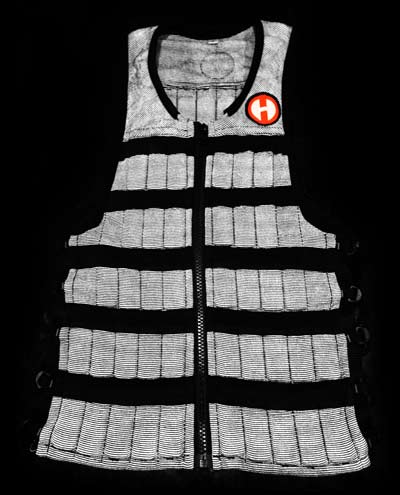
By Carl Valle
Training with loaded garments is nothing new. However, many coaches have causally tossed heavy vests onto athletes expecting to get results with the “just add weight” mentality for years. The problem with this idea, which is similar to medicine balls being added to exercise routines, is that no guidelines really exist beyond coaching adages and folklore. Adding weight with the use of a loaded vest is a valuable option if it’s done correctly. If done incorrectly, injury and failed adaptations will render great programs dangerous or ineffective. For years, I have used weighted vests judiciously and carefully, and have learned some great points from wiser coaches who have seen it all. In this article, I will share some guidelines, workout ideas, and even a few tips on making existing training better with weighted vests. Using weighted vests is sort of an open jungle with training, as nothing really exists besides a few studies on how weighted vests affect speed and power training. However, we are now starting to see some good ideas being clarified with specifics and smart advice. Weighted vests are a great option and are good investments (no pun intended) for those who want a quick and smart way to improve athletic development.

Understand the Speed and Power-to-Weight Ratio
Throwing weighted vests on is seen as a quick fix by personal trainers to make things new again. Unfortunately, the same issues with sled training and medicine ball training are showing up with weighted vests: not too many understand how loads effect training specifically. One way to think about weight vests are how power and speed are affected by hyper-gravity. Sleds use friction to increase demand and will change many of the neuromuscular adaptations, but sleds add more resistance horizontally by adding weight vertically. The forces through vests are similar to sleds as they create an overall higher demand, but the demands are unique. In addition to the direction of the forces, how velocity interacts with weighted vests is something to consider. Using a ten-pound vest on 300-pound athlete doing squat jumps may not be very impactful, but a 5-10 pound load on a 175 pound sprinter may perform a maximal fly. Weighted vests are great for early developers with low absolute strength levels, enabling those with poor abilities to express force to get stronger. Elite athletes who have a great power-to-weight ratio will find a small percentage of one’s weight to be less of a factor since elite athletes tend to be bigger athletes and have a greater ratio from long-term adaptations. All of this may sound confusing since an out-of-shape elite athlete may be using the same vest as a beginner high school athlete doing maximal-effort strength work. Estimating the effects of adding weight to one’s center of mass is not easy, but some general rules exist here. Classic principles of training still ring true with weight vests, but the details below can add more insight.
Rule One — The goal of light vests are to make simple body weight exercises more challenging instead of adopting exercises that don’t progress cleanly. For example, push-ups usually progress by adding more reps or making the exercise more difficult, but adding weight to the exercise is an excellent way to improve gross strength without learning new exercises or making changes to exercises. Variety in new exercises is a great tool, but save that card for a different time, and do not blow all of the variations early.
Rule Two — Power exercises need small external loads, and vests, while worn like a second skin, follow the same guidelines. Repeat jumps benefit greatly with vests, but single-leg hops should focus on higher velocities. Treat heavy vests as advanced power exercise enhancers and beginner strength tools.
Rule Three — Some evidence exists that vests may help with speed and focus on late acceleration with weighted vests. Maximal speed is such an infrequent event in training don’t slow it down, but late acceleration can benefit with a vest when sleds start to lose their value. Many vests have attachments to add horizontal forces via bands or cables, but sometimes, a clear message to the body is smarter than trying to ride too many horses at once.

Distribute the Load Better with Vests
Weighted vests load the body evenly near the center of mass. Weighted pants and ankle weights start making the load a little more complicated and risky as they start moving distally towards the extremities. I love vests for many reasons, but very heavy vests (40 pounds or more) are great ways to add load without compromising areas that sometimes don’t receive bars well. Many female athletes and some lighter sports where muscle mass of the traps is modest find heavy loads to be a little bit of a problem as the weights get higher. Sometimes, those doing dumbbells find that the options become limited or grips fail. Adding a vest is a great way to add weight, but the weight added is not on one part of the body but evenly distributed. Athletes are training to get better, and some are not blessed with the toughness or willingness to put a bar on the back. A compromise is to add a vest, not only for a lighter bar load, but also because some vests add a little padding without using a bar cushion. I am agnostic to any mentality of lifting, and the goal is to move the needle forward and not stick with cultures that don’t jive with all athletes.

Immediate Body Composition Benefits
Adding 10% more load doesn’t mean 10% more fat loss, but with any general capacity training, addressing body composition is always going to be a component of programs in the offseason and sometimes longer. Very easy workouts on paper can be transformed to hard training sessions with just a small load. There are two key reasons I love weight vests in the offseason or early preseason, and the first one is teaching the value of leanness. Nothing wakes up an athlete who needs to improve body composition more than a weight vest. One can push out a few smoothie recipes or shopping lists all they want, but actually feeling the weight is often the tipping point to getting an athlete to adhere to a nutritional and training program. An immediate reduction in performance from added weight doing basic activities is a wake-up call that coaches can use later. Second, a weight vest, if light enough, doesn’t interfere with the theme of the workout by changing it to something unintended and can help burn more calories in less time. While not glamorous, focusing on body composition is a smart and relevant way to improve performance and is often neglected because it isn’t as fancy or sexy as exotic periodization from Russia or cool new equipment options.

Challenge Motor Learning and Mobility Training
One of the great teaching tools is ironically one of the most common mistakes: adding weight to solve problems. I find that a small amount of weight really keeps people honest with coordination and mobility activities. Hurdle mobility, for example, forces an athlete to be more active and aware walking and maneuvering with a small load rather than just rushing through the motions. Simple activities with balance force athletes to be more aware of the center of gravity because they are heavier. Simply put, just a small amount of weight is a gentle reminder of gravity being the ultimate judge of efficient movement and the ability to express flexibility actively. Flexibility in isolation is valuable, but under load or speed the transferable qualities are revealed. Some good ideas are adding heavy vests to isometric or planking movements and light vests to conventional exercises. Isometric positions teach body awareness by literally slowing down the pattern to a standstill. Adding heavy weight to isometrics or static holds is appropriate, but full range and more demanding patterns just needs a light reminder. End range loading with a light pattern helps reinforce mobility patterns and is popular with many programs in the early preseason time period.

Enjoy Upper Body Freedom
A weighted vest allows the use of the arms, an underrated benefit when doing jumping exercises. Athletic actions are not just about overloading the muscles that create propulsion; training needs to think about simple ways to create overload without changing the activity to a different movement pattern. One example of using weighted vests and exploiting arm freedom is the use of walking lunges with the hands behind the head. As shared earlier regarding medicine balls, the use of weighted vests is about general or total body overload as the distribution is even, while medicine ball overload is usually specific and local. Upper body mechanics encourages athletes to sustain the techniques learned without external loads by performing natural patterns with resistance. Sometimes other external loads can be added to the vest in a combination, but they mainly work for assistance exercises such as single leg training. Most athletes like the rhythm of keeping a vest on while doing a bunch of general total body exercises and feeling the transition of switching equipment. Weight vests liberate athletes to move freely, adding in external loading but making it feel internal and natural.

Example of a weighted vest by Hyper Vest
Closing Thoughts on Weighted Vests
Weighted vests, like any tool, need to be used deliberately and not simply tossed in the mix of training. Due to the easy application—literally putting on a garment—weight vests are extremely deceptive and are often forgotten or underestimated until too late. As a precaution, weight vests should be seen as a way to make familiar exercises harder for beginners, and mastered exercises safer for elite athletes trying to add intensity. Stepping back weighted vests are likely to represent that common “5% of the program” adage, meaning that the most-experienced coaches realize that no matter how great something is, it’s only a small part of a well-organized program and not a primary factor. If you are looking to intelligently and gradually fine tune a good program by adding the right load, weighted vests are excellent if placed in the right areas.
Please share this article so others may benefit.
[mashshare]Tips for using weighted vest in training http://t.co/4CSIPwNrzw
— Andrew Flatt (@andrew_flatt) August 6, 2014



Hi Carl!
As usual, good points! I agree with this observation: “Many female athletes and some lighter sports where muscle mass of the traps is modest find heavy loads to be a little bit of a problem as the weights get higher.”
This is another key insight: “Athletes are training to get better, and some are not blessed with the toughness or willingness to put a bar on the back.”
I’m not married to the deadlift as many believe, but for reasons noted above, it’s on option that works for our kids. Our high school girls aren’t comfortable with bars across shoulders, but they like the DL, and many are able to pull 2x bodyweight as they progress through our relatively short season. I have experimented with different vests, and back in the early ’90’s used an old system that I think was called Just Jump. It was similar to SquatFlex in that giant rubber bands connected to a metal base. The bands in this system were designed to be harnessed over the athlete’s shoulders.
I thought that would be a good alternative to the squat because it was non-threatening and removed the need for spotters, but my kids quickly found it pretty boring because it was hard to measure progress, aside from moving up to a thicker band. Even that wasn’t a motivator, since there were only three different bands And with just one system and several athletes, it was became a time waster. Since an athlete’s height influenced the tension, I was either wrapping or unwrapping sections of the bands attached to the supports arms.
Vests were problematic because I had a limited number of them, and in trying to adjust the weight to each athlete, too much of my time was spent pulling lead plates out of pockets.
But vest design has indeed come a long way over the past twenty years.
Hi Carl !
Thank for writing this. Your point is good and I agree with this observation. Weighted Vest is important of delay life. The bands in this system were designed to be harnessed over the athlete’s shoulders.
Vests were problematic because I had a limited number of them, and in trying to adjust the weight to each athlete, too much of my time was spent pulling lead plates out of pockets.
Weighted vest/jackets are a superb way to add extra resistance to your workout whether you are running, jumping or lifting weights. I have been known to go dog walking in my weighted jacket, which helps with increasing training volumes without taking any extra time out of your usual routine.
Great article Carl!! Thank you for your sensible writing !
Kind regards,
Michael
Elevate your workout routine with the female weighted vest. Feel the comfort and the added build to your body. Challenge your mobility along with the training and drop some extra kilos while working out with some added weight in your vest.